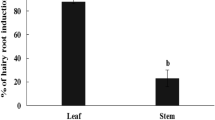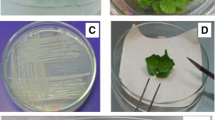Abstract
Centella asiatica contains various triterpenoids, including madecassoside, asiaticoside, madecassic acid, and asiatic acid. Among them, they are mainly contained in leaf, and among them asiaticoside is known as tissue-specific compound that are mainly accumulated in the leaves. Therefore, in the present study, C. asiatica hairy root cultures were established from petiole and leaf explants using Agrobacterium rhizogenes-mediated transformation. To promote the biosynthesis of these triterpenoids, hairy root cultures were treated with precursors (squalene and pyruvic acid) and elicitors [methyl jasmonate (MeJA) and salicylic acid (SA)] at various concentrations. No significant difference was detected in the growth index of hairy root cultures between precursor feeding and elicitation, except pyruvic acid feeding, suggesting that elicitors do not affect the growth of hairy roots. Treatment with 2.5 mM squalene and 5 mM pyruvic acid enhanced the biosynthesis of target triterpenoids (57.53 and 29.13 mg g−1 DW, respectively) compared with other treatments. However, compared to squalene, MeJA showed a greater effect on the triterpene saponin content in C. asiatica. The highest quantity of triterpenoids (60.25 mg g−1 DW) was produced in hairy root cultures treated with 400 μM MeJA. These results indicate that precursor- and elicitor-treated C. asiatica hairy root cultures rapidly accumulate biomass and could be used to enhance the production of triterpenoids for industrial purposes.





Similar content being viewed by others
References
Bohm H, Mack G (2004) Betaxanthin formation and free amino acids in hairy roots of Beta vulgaris var. lutea depending on nutrient medium and glutamate feeding. Phytochem 65:1361–1368
Bonfill M, Mangas S, Moyano E, Cusido RM, Palazón J (2011) Production of centellosides and phytosterols in cell suspension cultures of Centella asiatica. Plant Cell Tiss Org 104:61–67
Chavan SP, Lokhande VH, Nitnaware KM, Nikam TD (2011) Influence of growth regulators and elicitors on cell growth and α-tocopherol and pigment productions in cell cultures of Carthamus tinctorius L. Appl Microbiol Biotechnol 89:1701–1707
Devkota A, Dall'Acqua S, Comai S, Innocenti G, Jha PK (2010) Centella asiatica (L.) urban from Nepal: quali-quantitative analysis of samples from several sites, and selection of high terpene containing populations for cultivation. Biochem Syst Ecol 38:12–22
Durner J, Shah J, Klessing DF (1997) Salicylic acid and disease resistance in plants. Trends Plant Sci 2:7
Gupta YK, Kumar MV, Srivastava AK (2003) Effect of Centella asiatica on pentylenetetrazole-induced kindling, cognition and oxidative stress in rats. Pharmacol Biochem Be 74:579–585
Ho TT, Lee JD, Jeong CS, Paek KY, Park SY (2018a) Improvement of biosynthesis and accumulation of bioactive compounds by elicitation in adventitious root cultures of Polygonum multiflorum. Appl Microbiol Biotechnol 102:199–209
Ho TT, Lee JD, Ahn MS, Kim SW, Park SY (2018b) Enhanced production of phenolic compounds in hairy root cultures of Polygonum multiflorum and its metabolite discrimination using HPLC and FT-IR methods. Appl Microbiol Biotechnol 102:9563–9575
James JT, Dubery IA (2009) Pentacyclic triterpenoids from the medicinal herb, Centella asiatica (L.) Urban. Molecules 14:3922–3941
James JT, Tugizimana F, Steenkamp PA, Dubery IA (2013) Metabolomic analysis of methyl jasmonate-induced triterpenoid production in the medicinal herb Centella asiatica (L.) urban. Molecules 18:4267–4281
Kang SM, Jung HY, Kang YM, Yun DJ, Bahk JD, Yang JK, Choi MS (2004) Effects of methyl jasmonate and salicylic acid on the production of tropane alkaloids and the expression of PMT and H6H in adventitious root cultures of Scopolia parviflora. Plant Sci 166:745–751
Kim YJ, Wyslouzil BE, Weathers PJ (2002) Invited review: secondary metabolism of hairy root cultures in bioreactors. Vitro Cell Dev Biol Plant 38:1–10
Kim OT, Kim MY, Hong MH, Ahn JC, Hwang B (2004) Stimulation of asiaticoside accumulation in the whole plant cultures of Centella asiatica (L.) Urban by elicitors. Plant Cell Rep 23:339–344
Kim OT, Bang KH, Shin YS, Lee MJ, Jung SJ, Hyun DY, Hwang B (2007) Enhanced production of asiaticoside from hairy root cultures of Centella asiatica (L.) Urban elicited by methyl jasmonate. Plant Cell Rep 26:1941–1949
Krisa S, Larronde F, Budzinski H, Decendit A, Deffieux G, Mérillon JM (1999) Stilbene production by Vitis vinifera cell suspension cultures: methyl jasmonate induction and 13C biolabeling. J Nat Prod 62:1688–1690
Le KC, Jeong CS, Lee HS, Paek KY, Park SY (2019) Ginsenoside accumulation profiles in long- and short-term cell suspension and adventitious root cultures in Panax ginseng. Hortic Environt Biotechnol 60:125–134
Lee CY (2000) Browning reaction, enzymatic encyclopedia of food science and technology, 2nd edn. Wiley, New York, pp 208–218
Lee J, Jung E, Kim Y, Park J, Park J, Hong S, Kim J, Hyun C, Kim YS, Park D (2006) Asiaticoside induces human collagen I synthesis through TGF beta receptor I kinase (TbetaRI kinase)-independent Smad signaling. Planta Med 72:324–328
Lee JS, Kim MY, Kim JH, Nam JH, Lee HY, Hwang B (2008) Production of salidroside in Rhodiloa sachalinensis A. Bor callus by the elicitation and precursor. Korean J Med Crop Sci 16:268–272
Lee EJ, Park SY, Paek KY (2015) Enhancement strategies of bioactive compound production in adventitious root cultures of Eleutherococcus koreanum Nakai subjected to methyl jasmonate and salicylic acid elicitation through airlift bioreactors. Plant Cell Tiss Org 120:1–10
Li HZ, Wan JY, Zhang L, Zhou QX, Luo FL, Zhang Z (2007) Inhibitory action of asiaticoside on collagen-induced arthritis in mice. Yao Xue Xue Bao 42:698–703
Liang X, Huang YN, Chen SW, Wang WJ, Xu N, Cui S, Yang M (2008) Antidepressant-like effect of asiaticoside in mice. Pharmacol Biochem Be 89:444–449
Loc N, Giang N (2012) Effects of elicitors on the enhancement of asiaticoside biosynthesis in cell cultures of centella (Centella asiatica L. Urban). Chem Pap 66:642–648
Mangas S, Bonfill M, Osuna L, Moyano E, Tortoriello J, Cusido RM, Palazón J (2006) The effect of methyl jasmonate on triterpene and sterol metabolisms of Centella asiatica, Ruscus aculeatus and Galphimia glauca cultured plants. Phytochemistry 67:2041–2049
Memelink J, Kijne JW, van der Heijden R, Verpoorte R (2001) Genetic modification of plant secondary metabolite pathways using transcriptional regulators. Adv Biochem Eng Biotechnol 72:103–125
Mullera V, Lankesa C, Zimmermannb B, Nogaa G, Hunschea M (2013) Centelloside accumulation in leaves of Centella asiatica is determined by resource partitioning between primary and secondary metabolism while influenced by supply levels of either nitrogen, phosphorus or potassium. J Plant Physiol 170:1165–1175
Murashige T, Skoog F (1962) A revised medium for rapid growth and bioassays with tobacco tissue cultures. Plant Physiol 15:473–497
Murthy HN, Lee EJ, Paek KY (2014) Production of secondary metabolites from cell and organ cultures: strategies and approaches for biomass improvement and metabolite accumulation. Plant Cell Tissue Organ Cult 118:1–16
Phillips DR, Rasbery JM, Bartel B, Matsuda SP (2006) Biosynthetic diversity in plant triterpene cyclization. Curr Opin Plant Biol 9:305–314
Punturee K, Wild CP, Kasinrerk W, Vinitketkumnuen U (2005) Immunomodulatory activities of Centella asiatica and Rhinacanthus nasutus extracts. Asian Pac J Cancer Prev 6:396
Qu J, Zhang W, Yu X (2011) A combination of elicitation and precursor feeding leads to increased anthocyanin synthesis in cell suspension cultures of Vitis vinifera. Plant Cell Tiss Org 107:261–269
Savitha BC, Thimmaraju R, Bhagyalakshmi N, Ravishankar GA (2006) Different biotic and abiotic elicitors influence betalain production in hairy root cultures of Beta vulgaris in shake-flask and bioreactor. Process Biochem 41:50–60
Sevón N, Oksman-Caldentey KM (2002) Agrobacterium rhizogenes-mediated transformation: root cultures as a source of alkaloids. Planta Med 68:859–868
Shohael AM, Murthy HN, Hahn EJ, Lee HL, Paek KY (2008) Increased eleutheroside production in Eleutherococcus sessiliflorus embryogenic suspension cultures with methyl jasmonate treatment. Biochem Eng J 38:270–273
Singh S, Gautam A, Sharma A, Batra A (2010) Centella asiatica (L.): a plant with immense medicinal potential but threatened. Int J Pharm Sci Rev Res 4:9–17
Sivanandhan G, Selvaraj N, Ganapathi A, Manickavasagam M (2014) Enhanced biosynthesis of withanolides by elicitation and precursor feeding in cell suspension culture of Withania somnifera (L.) Dunal in shake-flask culture and bioreactor. PLoS ONE 98:e104005
Sudha G, Ravishankar GA (2003) Elicitation of anthocyanin production in callus cultures of Daucus carota and involvement of calcium channel modulators. Curr Sci 84:775–779
Walker JRL, Ferrar PH (1998) Diphenol oxidases, enzyme-catalyzed browning and plant disease resistance. Biotechnol Genet Eng Rev 15:457–498
Whitmer S, van der Heijden R, Verpoorte R (2002) Effect of precursor feeding on alkaloid accumulation by a tryptophan decarboxylase over-expressing transgenic cell line T22 of Catharanthus roseus. J Biotechnol 96:193–203
Xu R, Fazio GC, Matsuda SP (2004) On the origins of triterpenoid skeletal diversity. Phytochemistry 65:261–291
Yoo NH, Kim OT, Kim JB, Kim SH, Kim YC, Bang KH, Hwang B (2011) Enhancement of centelloside production from cultured plants of Centella asiatica by combination of thidiazuron and methyl jasmonate. Plant Biotechnol Rep 5:283–287
Yu KW, Gao W, Hahn EJ, Paek KY (2002) Jasmonic acid improves ginsenoside accumulation in adventitious root culture of Panax ginseng CA Meyer. Biochem Eng J 11:211–215
Zhao J, Verpoorte R (2007) Manipulating indole alkaloid production by Catharanthus roseus cell cultures in bioreactors: from biochemical processing to metabolic engineering. Phytochem Rev 6:435–457
Zhao J, Davis LC, Verpoorte R (2005) Elicitor signal transduction leading to production of plant secondary metabolites. Biotechnol Adv 23:283–333
Acknowledgements
This work was supported by the Korean Institute of Planning and Evaluation for Technology in Food, Agriculture, Forestry and Fisheries (IPET) through the Advanced Production Technology Development Program, funded by the Ministry of Agriculture, Food and Rural Affairs (MAFRA) (Grant number 315013–4).
Author information
Authors and Affiliations
Contributions
SYP conceptualized and designed this study. SEB, TTH, and YEK acquired the data and wrote the manuscript. HSL, GYJ and CSJ participated in the interpretation of data and revision for important intellectual content.
Corresponding author
Ethics declarations
Conflict of interest
The authors declare that they have no conflict of interest.
Additional information
Publisher's Note
Springer Nature remains neutral with regard to jurisdictional claims in published maps and institutional affiliations.
Rights and permissions
About this article
Cite this article
Baek, S., Ho, TT., Lee, H. et al. Enhanced biosynthesis of triterpenoids in Centella asiatica hairy root culture by precursor feeding and elicitation. Plant Biotechnol Rep 14, 45–53 (2020). https://doi.org/10.1007/s11816-019-00573-w
Received:
Accepted:
Published:
Issue Date:
DOI: https://doi.org/10.1007/s11816-019-00573-w




